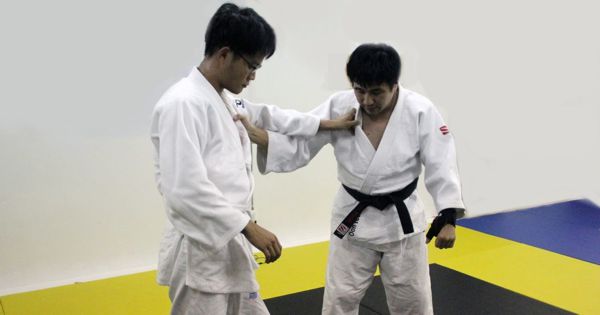In order to truly understand the difference between the terms Ai-Yotsu and Kenka Yotsu, one should dismiss the definitions of so called right-handed and left-handed fighters. The rationale for this suggestion will become readily apparent later in this paper.
The most popular accepted definitions of right-handed and left-handed fighters are as follows: When a right-handed fighter meets another right-handed fighter they call it Ai-Yotsu. Conversely, when a right-handed fighter meets a left-handed fighter they call it Kenka Yotsu. These definitions sorely lack what truly defines left-handed and right-handed.
The following definitions of Ai-yotsu and Kenka Yotsu are more exact and would eliminate any misunderstanding in the mind of any student first exposed to these definitions.
Ai-Yotsu is the basic judo fighting stance whereby both tori and uke use the same hand (right or left) as the Hikite (pulling) hand. A stance in which both players grasp each other’s left sleeve with the right hand or the right sleeve with the left hand. Kenka Yotsu is the basic judo fighting stance whereby both tori and uke use opposite hands (right or left) as the Hikite(pulling hand).
In the previous paragraph it should be noted that the definitions of Ai-Yotsu and Kenka Yotsu are based on the STANCE of both players and NOT whether they are right-handed or left-handed fighters. Also, when one refers back to the second paragraph of this article, the commonly accepted definitions of Ai-Yotsu and Kenka Yotsu are based on how players FIGHT and not on the STANCE of the players which is as it should be!
In assigning this definition, somehow what was missed was the fact that two variables exist here. One is stance and the other is fighting methods. The definitions for Ai-Yotsu and Kenka Yotsu are based on stance only and are in no way related to how the players fight. This writer would go so far as to say that it is not possible to conclude how any given player would fight from either an Ai-Yotsu or Kenka Yotsu stance.
It is therefore suggested that the definitions of Ai-Yotsu and Kenka Yotsu as outlined in paragraph four of this article be used as the meaning of these two terms without regard to fighting methods.



